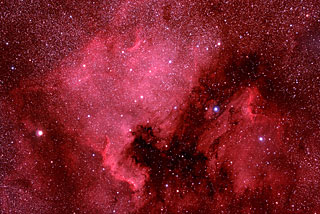The North American and Pelican Nebulae in Cygnus
Discovered by William Herschel in 1786 and favorites of astrophotographers, the huge North American (NGC 7000, left) and the smaller, dimmer Pelican (IC 5067/5070, right) Nebulae in the constellation Cygnus are respectively estimated to be 1,600 and 4,000 light years distant. The intricate, eastern edge of Mexico and Central America is known as the Cygnus Wall, a region of hot gas, dust and young stars. Obviously, the Gulf of Mexico is not a real gulf, and neither is it "a hole in the sky." It is dark nebulosity. Seven foreground stars here form an asterism. It is called "Little Orion." Do you see it?
This LRGB image was assembled with the help of FITS Liberator and colorized with pass-through layer sets. Credit for the image data follows.
This fits liberator image is not available for sale.
Credit:About the FITS Image
| Id: | todd_nolan_3 |
| Name: | Todd Nolan |
| City: | San Francisco, California |
| Country: | USA |
